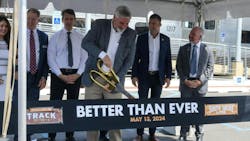OP-ED: The 9-to-5 commute may be over: The U.S. commuter rail renaissance is just beginning
Commuter railroads in the U.S. are ready to blossom. If given the same funding, attention and opportunities that Amtrak has received in recent years, commuter rail services can break the gridlock many of our major metros face every day, continue to deliver strong return on investment for the communities they serve, help meet aggressive sustainability targets and boost downtown businesses still struggling to match their pre-pandemic trade.
A new commuter rail renaissance is underway. We are reimagining the traditional morning-in, evening-out commuter rail schedule that has evolved in the post-pandemic work and travel environment. Our customers still want great service, but they also demand we operate outside of the old “peak” service in a regional rail model that suits hybrid work schedules and runs frequently in both directions throughout the day.
COVID-19 changed how many people plan and organize their workday. It's no longer the case that there are thousands of people moving into the city center at the same time every day. With the right resources, commuter railroads can accelerate and expand the new regional rail model. Without those resources, a real opportunity to contribute expanded service to our riders and local stakeholders will be missed.
This transformation will require a focused and collaborative effort. Many commuter railroads face a fiscal cliff in the short-term that must be solved with both the necessary operational funding and an infusion of capital investment. Commuter railroads are vital public services — and they can be doing more for commuters and their communities if we empower them with what they need to adapt and grow.
Commuter rail is worth the investment
Before the pandemic, commuter railroads across the U.S. moved approximately half a billion people every year. For reference, Amtrak moved only 32 million passengers in 2019.
When the pandemic first struck, roads were empty. However, traffic soon returned and today congestion in many cities is worse than ever. Commuter rail is a key component in any plan to shift people out of cars and onto public transit — a fundamental requirement to begin mitigating the impacts of climate change. Rail travel produces significantly lower greenhouse gas emissions than road or air transportation, which means shifting trips to passenger rail will reduce overall transportation emissions.
When we take cars off the road, everyone benefits — not just from the reduced emissions, but also by freeing up lanes for people who must travel by car. Commuter rail also offers cost savings for individuals and families — the average annual cost of car ownership, by AAA’s estimate, is more than $12,000. Moreover, proximity to rail is proven to increase the property values of homes and businesses close to train stations, according to data from the National Association of Realtors.
Transit advocates and agencies recognize the value of a regional approach to rail capable of luring commuters out of cars. In Toronto, Ontario, more than $11 billion in projects are underway for the GO Transit expansion intended to deliver faster trains, more stations, and seamless connections in a regional rapid transit network. Advocates in Boston, Mass., are also pushing for a transition to regional rail, aiming to update scheduling for the Massachusetts Bay Transportation Authority and establish free transfers to subways and buses. The recently rolled out expansion of the South Shore Line system in northwest Indiana added 14 new trains to their schedule with most of the new service operating outside of the traditional rush hours to meet the demand for regional rail.
Factors obstructing the rail renaissance
Some of the hurdles standing in the way of regional models are tactical: Crew staffing in a competitive market with low unemployment, vehicle availability and track access. Notably, agencies that don’t own their own rail must negotiate — and pay for — access and time slots with the owner, which could be a Class 1 freight railroad. Other obstacles must be dealt with by forward-thinking funders in Washington and state legislators who have a responsibility to their commuter rail constituencies.
Looking ahead, commuter rail needs infrastructure funding to maintain safe and reliable service and to target key opportunities for growth. One straightforward intervention is to fix a glaring issue in a federal program — the curiously-named Consolidated Rail Infrastructure and Safety Improvement (CRISI) Program — a program that excludes public commuter rail services and the hundreds of millions of riders that we serve.
Instead, CRISI grants fund infrastructure and safety upgrades to Amtrak and for-profit private sector short-line railroads moving freight. Moreover, since CRISI was first initiated, Amtrak has also seen its access to direct funding grow exponentially. While having a first-class national passenger rail network such as Amtrak is important, our commuter rail network is equally worthy of investment.
Commuter railroads that seek discretionary grant funds from the U.S. Department of Transportation must compete with all other surface modes — including pedestrian walkways, other public transit providers and bicycle paths — for limited funding. If this oversight was corrected, commuter railroads would use CRISI funding to make targeted investments in high value infrastructure and safety projects, including expensive but necessary repairs to bridges and grade crossings.
Reclaiming a vital public service
Across the country, commuter rail is a collective public asset that provides essential service for society but for commuter rail to maximize its value in the decades to come, the service must be resourced to adjust to the new normal. Before COVID-19, commuter rail passengers used their local service in a consistent, predictable way. The industry is adjusting to shift to a regional model in order to meet passengers’ new expectations.
The days of a predictable 9-to-5, Monday through Friday commute are likely over for good. Everyone — rail operators, legislators and customers alike — must work together to remove roadblocks and support services that will enable a renaissance for commuter rail in the U.S..
About the Author

KellyAnne Gallagher
CEO, Commuter Rail Coalition
KellyAnne Gallagher is CEO of the Commuter Rail Coalition. The coalition is an association of commuter rail agencies, operators and other interested parties acting together to engage and educate stakeholders on the value commuter railroads bring to the communities they serve.
Gallagher has transit and passenger rail experience through past positions with the American Public Transportation Association and New York Metropolitan Transportation Authority; she is also a a credentialed association exectuive.
